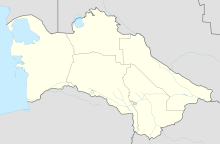Monjukli Depe
Coordinates: 36 ° 50 ′ 54 ″ N , 60 ° 25 ′ 4 ″ E
Monjukli Depe is a locality on the northern edge of the Kopet Dag in the south of Turkmenistan . The excavation site shows findings from the late Neolithic of the Jeitun culture and the early Eneolithic ( Copper Age ). The prehistoric settlement lies in an arid alluvial plain , which is bounded in the north by the Karakum desert and in the south by the slopes of the Kopet Dag. The mountains also mark today's political border with Iran . Wadi Meana, where the modern village of Meana is located, runs about three kilometers west of the village . Not far from the prehistoric village is the large Bronze Age settlement of Altyn Depe .
research
The first excavations took place in 1959 by Aleksandr A. Marushchenko and were later continued by his colleague OK Berdiev. The results of this first investigation have been compiled in a preliminary report. In 2010 the potential of the excavation site was recognized by Susan Pollock and Reinhard Bernbeck , which was the occasion for five further excavation campaigns (2010-2014) on site.
chronology
The site is important for a regional chronology, because Eeneolithic over Neolithic layers occur here. However, the new excavations have found a long break in the settlement between the end of the Neolithic settlement (layers XV, 6200-5600 BCE) and the Eeneolithic repopulation (layers IV to I, 4650-4340 BCE). The special features of the place led to the definition of a “Meana horizon”, which seems to be regionally limited to the Kaka region and which precedes the Anau IA phase.
Eneolithic settlement
Layers IV to I were excavated over a large area. They contain standardized houses with a square floor plan and a division into two halves using pillars. The upper two layers are marked by a straight path through the settlement and a gate at the east end. This gate led into a lockable open area in which, according to identification of the animal bones, feasts took place. In the lowest layer IV, a house with a wall painting of two human individuals and abstract patterns was found.
The residents of Monjukli Depes lived from herding and agriculture. Sheep and goats are particularly dominant among the herd animals. Cattle, including their skulls, played a major role at the feasts. Among the wild animals, the gazelle and onager should be highlighted. Barley and wheat were important in arable farming, with analyzes potentially suggesting ease of irrigation.
Very little pottery was made in the Eeolithic Monjukli Depe. On a general level, there are parallels to the Sialk II / Cheshme Ali horizon of the Iranian highlands .
literature
- Reinhard Bernbeck , Susan Pollock : Scalar Differences: Temporal Rhythms and Spatial Patterns at Monjukli Depe, Southern Turkmenistan . In: Antiquity 90 (349), 2016, pp. 64–80 doi: 10.15184 / aqy.2015.197
- Susan Pollock, Reinhard Bernbeck, Brian Beckers, Norbert Benecke , Jonas Berking, Gabriela Castro Gessner, Jana Eger, Birgül Öğüt: Archaeological Work at Monjukli Depe: A Regional Perspective . In: Archaeological Communications from Iran and Turan, Volume 47, 2018, pp. 1–47
- Susan Pollock, Reinhard Bernbeck, Birgül Öğüt (eds.): Looking Closely. Excavations at Monjukli Depe, Turkmenistan, 2010–2014. Sidestone Press, Leiden 2019 ( fully readable online )
- David R. Harris: Origins of Agriculture in Western Central Asia: An Environmental-Archaeological Study . University of Pennsylvania Press, Philadelphia 2010
- Fredrik T. Hiebert, The Kopet Dag Sequence of Early Villages in Central Asia . In: Paléorient 28 (2), 2002, pp. 25–41
- Herrmann Müller-Karpe : Neolithic settlements of the Dzejtun culture in South Turkmenistan. CH Beck, Munich 1982
- Raphael Pumpelly: Explorations in Turkestan, Expedition of 1904: Prehistoric Civilizations of Anau, Origins, Growth, and Influence of Environment . Volume 1, Carnegie Institution of Washington, Washington 1908
Individual evidence
- ^ Susan Pollock, Reinhard Bernbeck, Brian Beckers, Norbert Benecke, Jonas Berking, Gabriela Castro Gessner, Jana Eger, Birgül Öğut: Archaeological Work at Monjukli Depe: A Regional Perspective . In: Archaeological communications from Iran and Turan . tape 47 , 2018, p. 1-47 .
- ↑ Monjukli Depe. Architecture and settlement plan. monjukli.net
- ↑ Reinhard Bernbeck, Susan Pollock ,: Scalar Differences: Temporal Rhythms and Spatial Patterns at Monjukli Depe, Southern Turkmenistan . In: Antiquity . tape 90 , no. 349 , 2016, p. 64-80 .

